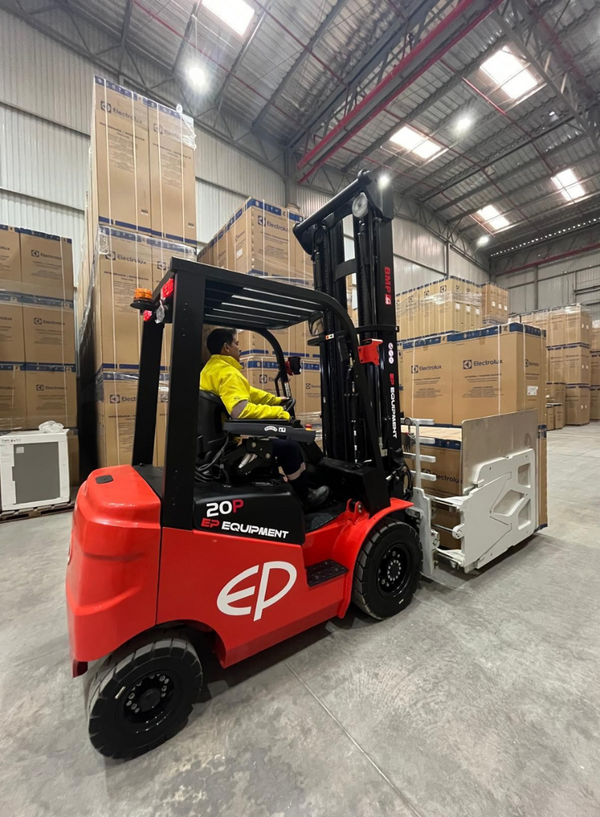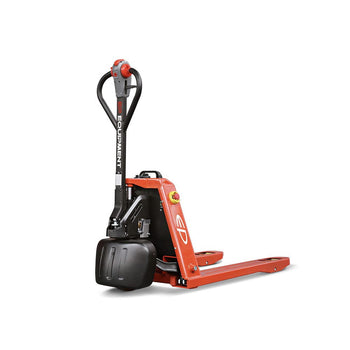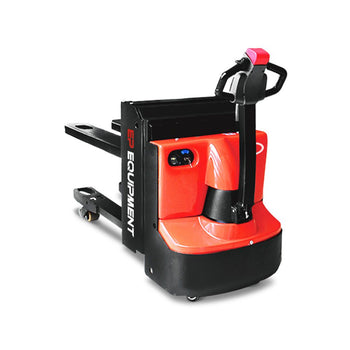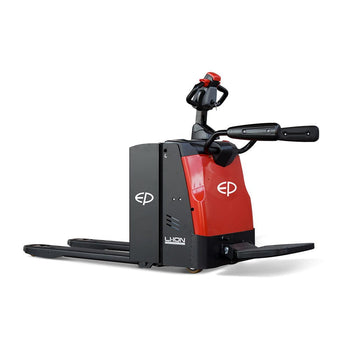Selecting the right lifting equipment makes a significant difference to warehouse productivity, safety and costs. Electric pallet stackers and forklifts both move palletised goods, but they are designed for different tasks. This guide explains the differences in load capacity, lift height, manoeuvrability and cost so that you can decide when an electric pallet stacker is the best fit and when investing in a forklift makes more sense. It uses recent information from material‑handling experts, health and safety guidance and iLift’s own product range.
Understanding Electric Pallet Stackers
An electric pallet stacker (sometimes called a walkie stacker) is a compact device that combines the simplicity of a pallet truck with a powered mast. These machines are designed to move pallets within confined areas and to stack them at modest heights. According to a warehouse equipment guide, most pallet stackers can lift loads between 2,000 and 4,000 lbs (about 900–1,800 kg), while forklifts can handle much heavier loads. Another specialist blog notes that walkie stackers typically move and lift pallets up to 4,000 lbs to heights of around 15 ft, and heavy‑duty models are rated for about 2,500 lbs. Key features of electric pallet stackers include:
-
Compact size – Stackers have a narrow profile and tight turning radius, making them ideal for cramped aisles and congested warehouses. iLift emphasises that their electric stackers offer “fantastic manoeuvrability that allows you to work in the tight spaces of a warehouse”.
-
Vertical reach – Most stackers lift pallets to 8–15 ft (2.4–4.5 m), sufficient for second‑tier racking.
-
Battery power and zero emissions – Electric stackers use rechargeable batteries. They can be plugged into standard outlets and do not emit fumes, making them suitable for indoor environments. iLift notes that their lithium‑ion stackers are easy to charge and produce no emissions, helping firms meet sustainability targets.
-
Lower cost and maintenance – Stackers cost less to purchase and maintain than forklifts and require less infrastructure.
-
Ease of use – The controls are straightforward; operators usually stand or walk behind the machine. Because stackers are classified as Class III powered industrial trucks, the training requirement is less intensive than for forklifts. UK guidance requires employers to ensure operators are trained and competent under the Provision and Use of Work Equipment Regulations 1998.
These characteristics make electric pallet stackers a cost‑effective solution for small warehouses, retail backrooms and light manufacturing where space is limited. They are also popular in cold storage and sensitive environments because they emit no fumes and operate quietly.

Load capacities and prices
When evaluating stackers, consider both the lift capacity and the mast height. iLift’s stacker range demonstrates typical options:
-
ESL122 electric stacker – offers a 1,200 kg lift capacity (about 2,650 lbs) with duplex mast heights of 3.0 or 3.6 m and starts at £3,599 (ex. VAT).
-
ES‑WA series stackers – heavy‑duty models rated at 1,200 kg or 1,600 kg with a 3 m lift height and lithium‑ion battery. They start from £8,683 (ex. VAT).
-
Other models such as the ES16‑RS and ESA121 provide similar capacities (1.2–1.6 tonnes) and ask‑for‑price options.
These price ranges illustrate that an entry‑level stacker can be obtained for around £3,600, while a premium lithium‑ion model costs around £8,700. Because electric stackers require less maintenance and have simpler designs, ongoing ownership costs are generally lower than those of forklifts.
Understanding Forklifts
A forklift is a powered industrial truck designed for lifting heavier loads and transporting them over longer distances. Standard forklifts can handle 3,000–5,000 lbs and heavy‑duty models can lift 10,000 lbs or more. The WarehouseWiz comparison notes that forklifts can lift loads from 3,000 to 50,000 lbs and reach heights of 30 ft (9 m), while an industry guide emphasises that some forklifts achieve lift heights over 30 ft. Important features include:
-
Higher lift capacity and height – Forklifts are built for heavy pallets, long and bulky materials, and high stacking. Electric counterbalance forklifts typically offer greater lift height than stackers.
-
Versatility – Forklifts are available in electric, gas and diesel models and can be equipped with attachments such as clamps, side shifters and buckets, enabling them to handle diverse loads. They are suitable for both indoor and outdoor use, including rough terrain.
-
Operator comfort and productivity – Forklifts have seats and protective cabs, reducing operator fatigue during long shifts. They travel faster than stackers and can move loads over longer distances.
-
Training requirements – The Health and Safety Executive (HSE) in the UK requires forklift operators to complete approved training and obtain a certificate. Employers must ensure operators are competent before allowing them to use either forklifts or pallet stackers.
Because of these advantages, forklifts are used in distribution centres, construction sites, manufacturing plants and any operation that involves high volume, heavy loads or outdoor work.
Typical forklift investment
Forklifts are a larger capital investment than stackers. iLift’s electric forklift line includes compact three‑wheel counterbalance models (EFL253/303/353) for warehouse work and heavy‑duty four‑wheel machines (CPD45/50F8) that handle up to 4.5–5 tonnes. Prices vary widely depending on capacity, battery technology and features. Although the iLift website does not list specific prices for its forklifts, businesses should expect to pay more than £15,000 for a new electric forklift; high‑capacity lithium‑ion models may cost considerably more. However, the higher initial investment can be justified by the lift capacity, versatility and long‑term durability.
Comparing Electric Pallet Stackers and Forklifts
The table below summarises the main differences between stackers and forklifts. To comply with SEO best practices, only short phrases are used in each cell.
|
Feature |
Electric Pallet Stacker |
Forklift |
|
Size / manoeuvrability |
Compact, narrow profile for tight spaces |
Larger chassis; requires wider aisles |
|
Load capacity |
1–4 tonnes (approx. 1,000–4,000 lbs) |
3–50 tonnes depending on model |
|
Lift height |
8–15 ft (up to 4.5 m) |
Up to 30 ft or more |
|
Power source |
Electric (lithium‑ion or lead‑acid); some manual models |
Electric, gas or diesel |
|
Cost |
Lower purchase and maintenance costs |
Higher initial investment; durable for heavy‑duty use |
|
Training |
Minimal training; employers must ensure competence |
Formal forklift certification required |
|
Typical applications |
Small warehouses, retail backrooms, light manufacturing |
High‑volume warehousing, manufacturing, construction |
|
Indoor/outdoor use |
Primarily indoor; limited ground clearance |
Indoor and outdoor, including rough terrain |
|
Operator posture |
Walk‑behind or ride‑on; more physical effort |
Seated operator; ergonomic cab |
|
Environmental impact |
Zero emissions; low noise |
Electric models emit no fumes; diesel models produce emissions |
When to Choose an Electric Pallet Stacker
Electric pallet stackers are the ideal solution for operations where space is at a premium and loads are modest. Use a stacker when:
-
Your warehouse has narrow aisles or congested areas. Stackers’ compact design and tight turning radius allow them to manoeuvre in aisles that would be inaccessible to forklifts. This makes them perfect for retail backrooms, small warehouses and light manufacturing.
-
Loads are light to medium. If your pallets seldom exceed 1–1.6 tonnes (2,000–3,500 lbs), a stacker provides sufficient capacity. Example: iLift’s ESL122 stacker handles 1.2 tonnes and costs around £3,600, while the ES‑WA series lifts up to 1.6 tonnes and starts at £8,683.
-
Lift heights are moderate. Stackers can typically lift to second‑tier shelving (3–4.5 m). For warehouses with mezzanine or lower racking, a stacker eliminates the need to invest in a large machine.
-
Cost and energy efficiency are priorities. Stackers cost less to purchase and maintain, and their battery‑powered operation reduces running costs and emissions. iLift’s lithium‑ion stackers charge quickly and operate quietly, helping companies meet sustainability goals.
-
You need flexibility in training and staffing. Although UK employers must ensure stacker operators are trained, the learning curve is shorter than for forklifts. This makes stackers suitable for businesses with high employee turnover or part‑time staff.
If these conditions describe your operation, consider exploring iLift’s electric stacker range. The company offers multiple models with lithium‑ion or lead‑acid batteries, capacities from 1.2 to 1.6 tonnes and lift heights around 3 m. Prices start at approximately £3,599 and go up to about £8,700, providing options for different budgets. iLift also provides support with product selection, financing, maintenance and global shipping, and all their machines are LOLER‑certified. Visit the electric stacker catalogue or call 01600 800 800 to discuss your requirements.

When to Choose a Forklift
Forklifts become the preferred choice when your operational needs exceed the capabilities of a stacker. Consider investing in a forklift if any of the following apply:
-
Heavy loads or high stacking. If your pallets regularly exceed 3–5 tonnes or require stacking beyond 4.5 m, a forklift is necessary. Forklifts can lift to 20–30 ft and beyond, making them indispensable for high‑bay warehouses.
-
Long travel distances or outdoor work. Forklifts move loads more quickly and over greater distances than stackers. Diesel or gas forklifts can operate outdoors and on rough terrain, making them suitable for construction sites and yards.
-
Versatility and attachments are required. Forklifts can be fitted with clamps, side shifters, rotators and other attachments, enabling them to handle drums, bales and unusual loads. This adaptability is not available with most stackers.
-
Continuous, heavy‑duty operation. Forklifts are built for rigorous use and feature ergonomic seating, reducing operator fatigue. They are better suited to multi‑shift environments and high‑volume throughput.
-
Outdoor or rough‑surface work. Electric or diesel forklifts offer higher ground clearance and robust suspension. This allows them to handle uneven terrain and weather exposure that would ground a pallet stacker.
If your operation meets these criteria, explore iLift’s electric forklift selection. Their EFL253/303/353 series combines compact design with lift capacities suitable for warehouses, while the CPD45/50F8 heavy‑duty models handle up to 5 tonnes. Electric forklifts from iLift feature lithium‑ion batteries for zero emissions and quiet operation, making them ideal for indoor use while maintaining the power and reach required for industrial applications. Because prices vary by model and specification, contact iLift for a tailored quote and guidance. They provide financing options and can help match the right forklift to your business needs.
Additional Considerations
Training and Safety
Although pallet stackers are easier to operate than forklifts, both are regulated under UK law. The HSE requires employers to ensure operators are properly trained and competent. For forklifts, a formal operator’s certificate is mandatory, whereas stacker operators should receive adequate training to operate safely under PUWER regulations. iLift offers support and advice on training and compliance.
Space and Layout
Analyse your warehouse layout and aisle widths. Aisle sizes under 2 m usually favour stackers or reach trucks; wider aisles may accommodate counterbalance forklifts. Consider potential future expansion - selecting equipment that accommodates growth can save on replacement costs.
Power and Battery Technology
Lithium‑ion batteries offer faster charging, longer run times and zero maintenance compared with lead‑acid batteries. iLift specialises in lithium‑ion technology and stocks EP‑brand equipment, a leading manufacturer in this field. Electric forklifts and stackers provide environmental and cost benefits over internal‑combustion models, particularly in noise‑sensitive or indoor applications.
Budget and Total Cost of Ownership
Evaluate not only the purchase price but also ongoing costs - energy consumption, maintenance, downtime and operator training. Stackers typically have lower operating costs, but they may not meet future capacity needs. Forklifts require a higher upfront investment, yet they can handle a broader range of tasks and may deliver better long‑term value for large operations.

Conclusion: Making the Right Choice
Electric pallet stackers and forklifts serve different purposes within the material‑handling spectrum. Stackers excel in compact spaces, moderate loads and cost‑sensitive operations, while forklifts dominate heavy‑duty, high‑reach and versatile tasks. Assess your facility’s space constraints, load requirements, budget and future growth to determine which solution fits best. Always ensure operators are properly trained and that your equipment complies with safety regulations.
iLift offers a full range of electric pallet stackers, pallet trucks and electric forklifts powered by advanced lithium‑ion technology. Entry‑level stackers start at around £3,599 and heavy‑duty models at £8,683. Their electric pallet trucks range from £1,750 for ex‑demo models to around £6,000 for high‑capacity units. All equipment is LOLER‑certified and supported by global shipping, maintenance and expert advice. Visit iLift’s online catalogue or call 01600 800 800 to discuss your needs and let their team guide you toward the right solution.





